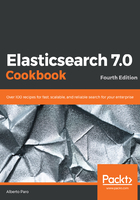
上QQ阅读APP看书,第一时间看更新
How it works...
The root object (document) controls the behavior of its fields and all its children object fields. In document mapping, we can define the following:
- date_detection: This enables the extraction of a date from a string (true default).
- dynamic_date_formats: This is a list of valid date formats. This is used if date_detection is active.
- numeric_detection: This enables you to convert strings into numbers, if possible (false default).
- dynamic_templates: This is a list of templates that's used to change the explicit mapping inference. If one of these templates is matched, the rules defined in it are used to build the final mapping.
A dynamic template is composed of two parts: the matcher and the mapping one.
To match a field to activate the template, several types of matchers are available such as:
- match: This allows you to define a match on the field name. The expression is a standard GLOB pattern (http://en.wikipedia.org/wiki/Glob_(programming)).
- unmatch: This allows you to define the expression to be used to exclude matches (optional).
- match_mapping_type: This controls the types of the matched fields. For example, string, integer, and so on (optional).
- path_match: This allows you to match the dynamic template against the full dot notation of the field, for example, obj1.*.value (optional).
- path_unmatch: This will do the opposite of path_match, excluding the matched fields (optional).
- match_pattern: This allows you to switch the matchers to regex (regular expression); otherwise, the glob pattern match is used (optional).
The dynamic template mapping part is a standard one, but with the ability to use special placeholders, such as the following:
- {name}: This will be replaced with the actual dynamic field name
- {dynamic_type}: This will be replaced with the type of the matched field
The order of the dynamic templates is very important; only the first one that is matched is executed. It is good practice to order the ones with more strict rule s first, and then the others.